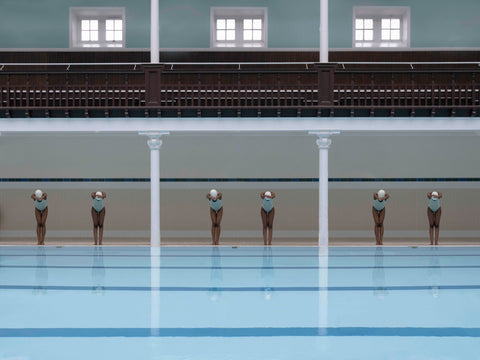
Scottish photographer Soo Burnell merges film-like stills and architecture in her satisfying photo art — a unity she’s found to be distinct at public swimming pools and cinemas.
WORDS: ERIK SEDIN, PHOTOGRAPHY: SOO BURNELL |
 |
The cultural phenomenon of public bathing and swimming pools is one of the modern times’ great communal spaces. Where does your fascination with swimming pools come from?
“I was reintroduced to the beauty of the incredible architecture of swimming pools in Edinburgh, my home city, while on a shoot at Glenogle, this Victorian swimming pool right in the heart of the city. At the time, I thought it would be a one-off project. It was the pool I learnt to swim in as a child and I’d go there during summer holidays.
“I really didn’t appreciate the architecture of the space in childhood though; I only really noticed it once I went back as an adult to photograph it. I spent years jumping in and out of that pool without paying any attention to the high ceilings, the rows of changing rooms flanking the pool, or the scale or grandeur of the space. As a child, it was something fun; it was about being in the water. Exploring these pools as an adult, I was fascinated by the architecture. And now my work explores my passion for architecture and composition, capturing the striking geometry along with the dramatic proportion and atmosphere of each individual space.”

Swimmers at the LAC Square |

Kaleidoscope Swimmers |
“Now my work explores my passion for architecture and composition, capturing the striking geometry along with the dramatic proportion and atmosphere of each individual space.”
Where do you find these hidden architectural treasures?
“Sometimes one location opens the door to another. For example, shooting Glenogle pool then led me to explore and photograph a number of historic public swimming pools around Edinburgh, and that then led to pools elsewhere in the UK and also to the incredible Molitor in Paris. Often it’s about researching online; sometimes things pop up on Instagram that I save to then look into. Sometimes I find something in a book. And sometimes people send me places — again, Instagram is helpful for this — that they’ve spotted and think I might like. It’s a real mix with a lot of research.”
Your photos look like reminiscences from a long time ago, like the photographs are from the 50s. Is this a conscious choice?
“There is nostalgia in my work, but this is something that evolved as opposed to something I set out to achieve. This is particularly apparent in my new Cinema collection, which I shot in two cinemas: The Scotsman Picture House in Edinburgh and the Regent Street Cinema in London. I chose both of these cinemas for their architecture and period references.”
“This sense of nostalgia has been a natural evolution and perhaps it also comes from other influences that feed into my work. For example, I am hugely inspired by and I have often mentioned how much my work is influenced by Wes Anderson. More recently I have been looking at cinematic imagery from other directors such as Terrence Malick, Stanley Kubrick, and Jean-Pierre Jeunet. They all have such great attention to detail. I also love the work of architecture photographer Julius Shulman. His book, A Constructed View, is beautiful. Californian architecture, along with impressionistic painting and composition, have long been influences of mine too.”
“I love hidden portraits, where the viewer has to wonder about the story of the character.”

Boys swim team Leith Victoria |

Water Polo at the LAC |
Not many of your photographs include faces. Why do you hide them?
“That’s an interesting question. I love hidden portraits, where the viewer has to wonder about the story of the character. If you consider my Poolside work, the eye is immediately drawn into the architecture, then the symmetry and reflections of the water, and finally to the swimmers, who highlight the scale of these spaces. The swimmers are crucial within this context as they bring a modernity to each scene; it’s as if the figures are breathing new life into these iconic spaces, but their presence is also visually ‘quiet’ within each frame. I want to create that sense of calm”
A few of your pictures are from London's Regent Street Cinema, why did you choose to photograph there?
“I chose two very different cinemas for the Cinema collection: The Scotsman Picture House, which is nestled deep within the landmark Scotsman Hotel on North Bridge in Edinburgh, and Regent Street Cinema in London. Regent Street Cinema opened in 1848 and is known as the ‘Birthplace of British Cinema’ as it hosted the first-ever screening of moving pictures in the UK. That sense of history felt important to me. Also, the building was refurbished recently and is now a jewel of modern Art Deco design so it was exciting to shoot there — and I loved the green velvet drapes!”
“There is nostalgia in my work, but this is something that evolved as opposed to something I set out to achieve.”

Here´s what we saw |
What would your dream building be to photograph?
“So many and my list keeps growing as I find more and more places! But thinking about my wish list, Japan and Berlin are top of my list of places that I’d like to visit and photograph. And I’ve just completed a new series of Parisian pools and I am also currently working on a series of my home town Edinburgh, documenting some of my favourite iconic buildings.”